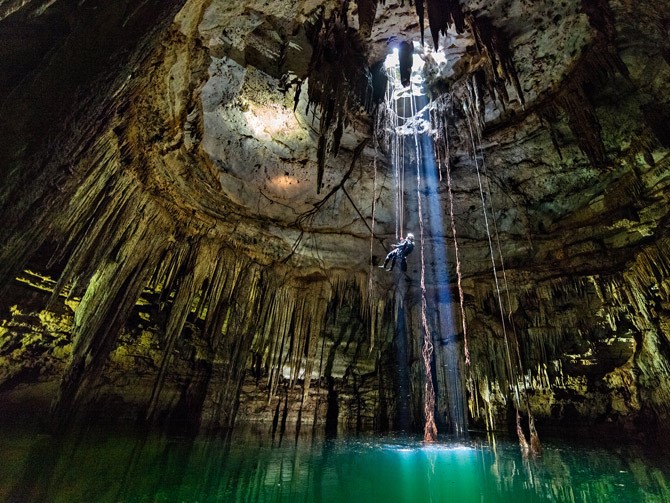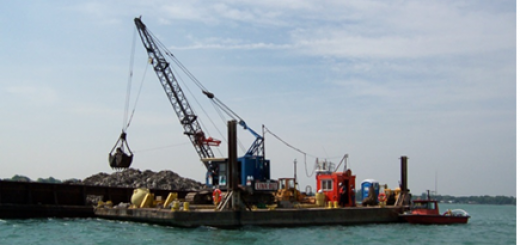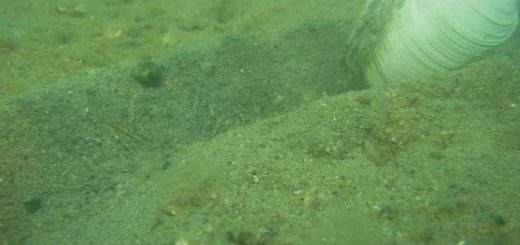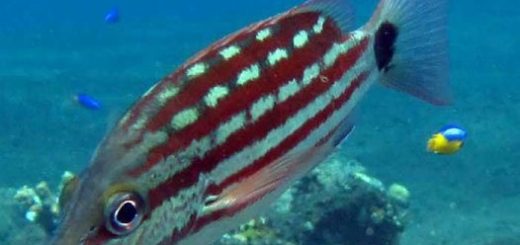Fish Community Structure in the Cenotes of Mexico
The Yucatán Peninsula is home to a unique group of underwater habitats that look like circular swimming pools. These beautiful formations are known as cenotes, meaning “natural well” in Spanish. Formed through the gradual wearing away of the limestone walls by freshwater river systems, cenotes offer an opportunity for snorkelers, scuba divers, and fish alike to enjoy swimming in the depths of the underwater cenote world.
Cenotes are a result of the constant, and widening, flow of underground rivers through limestone caverns. Freshwater moves through the caverns eventually widening them to a point where the ground above can no longer be supported and falls in. Although they are described by the authors as “the most important aquatic system in Yucatán Peninsula,” the abiotic factors that affect the structure of the fish communities living in these systems are not fully understood. Therefore, Camargo-Guerra and coauthors (2013) set out to examine morphology, water chemistry, and primary production in cenotes, focusing on how these factors influence and shape the fish communities that live there.
Cenotes vary in shape and size and as they are formed by the movement freshwater underneath the ground. Although they are permanent aquatic systems, they are frequently changing. The limestone caverns continue to be worn away as time passes, which gives them different shapes such as bucket-shaped cenotes or cenotes with shores. These features can influence the fish populations living in the cenote. Camargo-Guera and coathors determined that the presence of a shoreline is a major component that in turn affects all other biotic and abiotic parts of the system.
Over the course of a four year study at the Biosphere Reserve of Sian Ka’am and Quintana Roo, Mexico, Cenotes Tres Reyes, Santa María, Límite, and Norte were examined. Phosphorus is described as the limiting resource in terms of the vegetation. The input of phosphorus is a result of erosion from rock and input from outside of the system. There were shorelines present development, in both Cenote Límite, and Norte. The more shoreline present in a cenote, the more plants that can colonize; therefore providing habitats and homes for a variety of fish species. More insects may find refuge in this shoreline vegetation algae; therefore, increasing a food source for the fishes. This, in turn, facilitated the greatest richness of fish species.
Camargo-Guerra and coauthors determined that cenotes represent a relatively stable environment, and are not known to change abruptly as the amount of rainfall varies from dry to wet seasons. After the authors confirmed that cenotes were stable systems, and in turn the fish population remained stable as well. Therefore, cenotes are inhabited by fish species such as Poeciliids, Cichlids, Caracid, Pimelodid, and the Synbranchid, which are species used to living in these types of stable environments.
Cenotes are unique and beautiful environments that can be enjoyed by people and fishes alike. Abiotic factors have been determined to have a large impact on the structure of fish communities in these aquatic systems. However, the extent of impact of these factors, such as shoreline formation, is not yet fully known. Better understanding this abiotic factor and fish relationship will lead to a better understanding how this truly affects the fish community structure in cenotes.
Literature Cited
Camargo-Guerra, T., Escalera-Vázquez, L.H., and Zambrano, L. (2013) Fish community
structure dynamics in cenotes of the Biosphere Reserve of Sian Ka’an, Yucatán
Peninsula, Mexico. Revista Mexicana de Biodiversidad. 84:901-911




